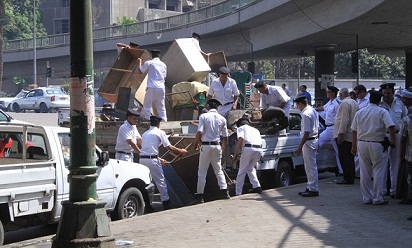TOKYO: The strongest earthquake ever to hit Japan Friday unleashed a terrifying 10-meter tsunami that washed away homes and tossed ships inland, with a nuclear plant among multiple sites set ablaze.
At least 116 people were listed as dead or missing after the 8.9-magnitude quake, which US and Japanese seismologists said was the fifth strongest tremor worldwide since 1900 and the seventh strongest in history.
"It was the biggest earthquake I have ever felt. I thought I would die," said Sayaka Umezawa, a 22-year-old college student who was visiting the port of Hakodate, which was hit by a powerful two-meter wave.
The monster wall of water set off tsunami alerts across the Pacific. A Japanese ship with 100 people aboard was carried away while more than 300 houses were destroyed in the remote city of Ofunato, reports said.
The tsunami of 10 meters (33 feet) hit near Sendai city where a tide of black water sent shipping containers, cars and debris crashing through streets and across open farmland, destroying everything in its path.
The government said the tsunami and quake, which was felt in Beijing, some 2,500 km (1,500 miles) away, had caused "tremendous damage" while aerial footage showed massive flooding in northern towns.
In Sendai, television pictures showed a wide, muddy tide moving with devastating speed and force across a residential area near the Natori River.
"I’ve never seen anything like this," said Ken Hoshi, a local government official in Ishinomaki, a port city in Miyagi prefecture where Sendai is located.
In the capital Tokyo, where millions evacuated strongly swaying buildings, multiple injuries were reported when the roof of a hall collapsed during a graduation ceremony, police said.
Plumes of smoke rose from at least 10 locations in the city, where four million homes suffered power outages. An oil refinery was ablaze near Tokyo.
The Pacific Tsunami Warning Centre issued a widespread warning for territories as far away as South America, New Zealand and Hawaii, where people were ordered to evacuate coastal areas.
The Red Cross warned that if the tsunami were to reach between four and 10 meters it would swamp some of the islands in its path. But countries in the tsunami’s path reported only minor waves.
The tsunami also reached Sendai airport, submerging the runway while a process known as liquefaction, caused by the intense shaking of the tremor, turned parts of the ground to liquid.
The government said it was operating on an atomic power emergency footing after a fire broke out in the turbine building of a nuclear plant in Onagawa but said no radiation leaks were detected among its reactors.
The first quake struck just under 400 km (250 miles) northeast of Tokyo, the US Geological Survey said. It was followed by more than 40 aftershocks, one as strong as 7.1.
"We were shaken so strongly for a while that we needed to hold on to something in order not to fall," said an official at the local government of the hardest-hit city of Kurihara in Miyagi prefecture.
"We couldn’t escape the building immediately because the tremors continued… City officials are now outside, collecting information on damage," she told AFP by telephone.
A major blackout occurred across a wide area of northeastern Japan.
Prime Minister Naoto Kan quickly assembled his cabinet after the quake hit, and the government dispatched naval vessels from near Tokyo to Miyagi.
US President Barack Obama led international offers of sympathy and aid in what he called Japan’s "time of great trial," while the Kan government called on help from US forces stationed in the country.
The quake affected Japan’s key transportation systems, including Narita airport, which shut its runways for safety checks to leave 10,000 passengers stranded, before reopening for departing flights only.
The quake, which hit at 14:46 pm (0546 GMT) and lasted about two minutes, rattled buildings in greater Tokyo, the world’s largest urban area and home to some 30 million people.
In Tokyo, where the subway system stopped, sirens wailed and people streamed out of buildings.
The quake sent the Nikkei share index plunging at the close while the yen fell sharply against the US dollar before recovering. Stocks in European re-insurers, which cover against major natural disasters, also dived.
Japan sits on the "Pacific Ring of Fire," which is dotted with volcanoes, and Tokyo is in one of its most dangerous areas where three continental plates are slowly grinding against each other, building up enormous seismic pressure.
The government’s Earthquake Research Committee has warned of a 70 percent chance that a great, magnitude-eight quake will strike within the next 30 years in the Kanto plains, home to Tokyo’s vast urban sprawl.
The last time a "Big One" hit Tokyo was in 1923, when the Great Kanto Earthquake claimed more than 140,000 lives, many of them in fires. In 1855, the Ansei Edo quake also devastated the city.
In 1995 the Kobe earthquake killed more than 6,400 people.
More than 220,000 people were killed when a 9.1-magnitude quake hit off Indonesia in 2004, unleashing a massive tsunami that devastated coastlines in countries around the Indian Ocean as far away as Africa.
However, small quakes are felt every day somewhere in Japan and people take part in regular drills at schools and workplaces to prepare for a calamity.
Nuclear power plants and bullet trains are designed to automatically shut down when the earth rumbles and many buildings have been quake-proofed with steel and ferro-concrete at great cost in recent decades.



